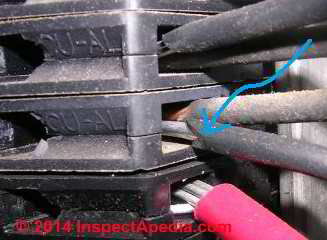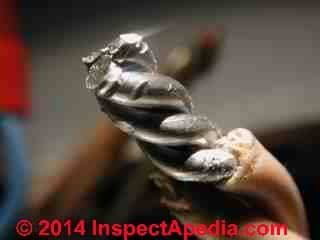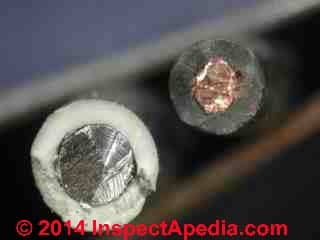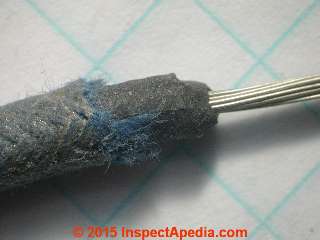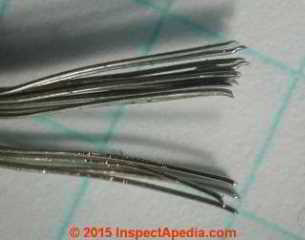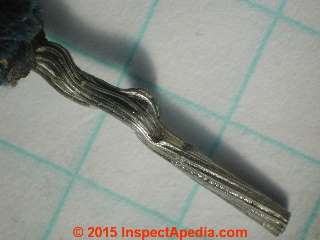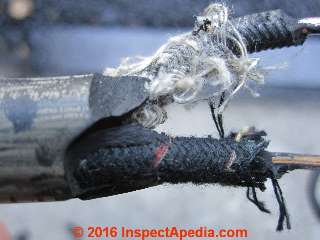 Tinned Copper Electrical Wire Identification
Tinned Copper Electrical Wire Identification
Identification & safety of tinned-copper electrical wiring
- POST a QUESTION or COMMENT about tinned-copper electrical wiring
Tinned-copper Electrical Wiring identification, safety, production methods.
This article describes methods for accurate identification of tinned-copper or "plated copper" electrical wiring and its safe use in buildings. Tinned copper wire should not be mistaken for aluminum electrical wire in buildings. Modern tinned copper wire is also known as "busbar wire".
This article includes illustrations of tinned copper solid conductor wire and tinned multi-strand copper wire are compared with copper wire to which solder was later applied.
InspectAPedia tolerates no conflicts of interest. We have no relationship with advertisers, products, or services discussed at this website.
- Daniel Friedman, Publisher/Editor/Author - See WHO ARE WE?
Avoid confusing copper-clad wire with tinned-copper plated wire or with COALR or CU-AL Devices
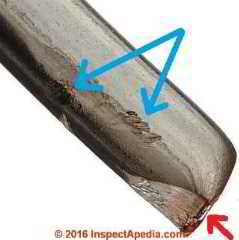 Tinned copper conductors in electrical wiring was introduced to combat oxidation and damage to copper conductors when they were insulated using a rubber sheath - a condition noted in the U.S. by the mid 1920s. The sulphur content in rubber insulation on wires interacted with the surface of the copper wire, damaging the conductors.
Tinned copper conductors in electrical wiring was introduced to combat oxidation and damage to copper conductors when they were insulated using a rubber sheath - a condition noted in the U.S. by the mid 1920s. The sulphur content in rubber insulation on wires interacted with the surface of the copper wire, damaging the conductors.
A thin coating of tin on the surface of the copper conductor was applied to both solid conductors and multi-strand conductors to protect the copper conductor from damage..
Here we describe observations that prevent confusing tinned copper wire or plated copper wire (safe in buildings) with solid single-conductor aluminum branch circuit wiring in buildings (unsafe).
Our page top photograph illustrates rubber and fabric-insulated copper wire that may have a dull silver color on the actual wire surface.
Our photo with the red and blue arrows, adapted from a contemporary tinned-copper electrical wire advertisement [Amazon.com] we can see the reddish copper color of the wire beneath its plating in two locations: at tool marks and scrapes on the wire surface and at the cut-end of the wire.
In modern applications tinned copper wire is used where extra corrosion resistance is needed such as in marine applications or "boat wiring".
In contrast with tinned copper or plated copper wire, below we see both a solid single strand and a multi-strand aluminum wire connected to circuit breakers.
Scratch the tin plating on this wire and you'll see shiny, reddish copper of the wire core. From that step we know that this is a tinned copper electrical wire, not aluminum wire.
Below in our photograph of wires inserted into several circuit breakers, even without any disassembly we can see a solid conductor aluminum wire (blue arrow) double-tapped (two wires under one connector) into a circuit breaker.
We see a copper wire and on top of it a silver-colored solid conductor electrical wire that is probably aluminum wire.
The large multi-strand red-insulated wire is a multi-strand aluminum conductor.
Watch out: Double-tapping electrical wire connections is improper and unsafe unless the connector is specifically designed for that purpose and is so-indicated by its manufacturer.
See details at DOUBLE TAPPED CIRCUIT BREAKERS
But from just this photograph alone one cannot be sure if the silver colored wire is aluminum or tinned "plated" copper.
Note: Tin plated copper wire was generally a practice used before 1965 on small-sized 14-12 copper wire. On second look, the size of the silver-colored black insulated wire shown above is likely to be a size 10 or 12 AWG aluminum. Further, tin-plated copper presents a "dirty silver" look. - D'Agostino (2014)
A closer look will be needed to confirm the opinions of our note above. Notice that the circuit breaker itself is marked CU-AL indicating that the manufacturer represented that the breaker could be used with either aluminum or copper wire, notwithstanding that CU-AL-marked devices are not an accepted nor recommended repair for aluminum electrical wiring.
Watch out: In addition to the improper double-tapping in the center circuit breaker shown above, copper wire in contact with an aluminum conductor in an AL-CU rated circuit breaker is not covered by the UL-listing. The device is listed for use with either copper-only or aluminum only.
Details are at ALUMINUM WIRING REPAIR COALR & CU-AL.
An easy photograph for aluminum wire identification is shown above right. This is of course from a different electrical connection - a splice that used a twist-on connector.
We can see silver-colored (soft) metal that is aluminum at three locations:
- The wire surface, silver colored. If this were all we could see we might not know (unless aided by printing on the wire insulation) whether we're looking at aluminum wire or plated copper wire.
But that white plastic insulation tells me this is not an older rubber-insulated wire so on that basis I'm already ruling out plated copper. But the next two observations confirm that conclusion. - The interior of nicks into the wire that would have most likely cut through any plated skin - so we are pretty sure that this is not tin-plated copper wire
- The square-cut end of the wire, silver colored throughout, so we know for sure that this is solid aluminum wire
Watch out: tin-plated copper wire is a completely different product that, because its conductors sport a thin plated silver colored surface, might be mistaken for unsafe aluminum wire. It is not aluminum and it is safe unless, as with any electrical wiring, it has been damaged in some manner.
Not all rubber insulated copper wire is plated, but if you suspect that the silvery-colored wire is plated copper, it's easy enough to determine: with the wire disconnected from any power source, scratch the silver colored surface of the rubber-insulated wire and you'll see its red copper interior.
In REDUCE THE AL WIRE RISK: DETAILS, as well as in Aronstein (2011). There Aronstein describes plated-copper wire as:
Plated copper wire [tinned copper wire] is relatively common in older homes, and it looks like aluminum wire. It was commonly used with rubber-based insulation. Identification can be made by careful inspection of a cut end of the wire.
In general, plated copper wire would not be present in nonmetallic sheathed cable ("Romex"), it is most generally found in metallic sheathed cable ("BX"). Cable of the "BX" type is not likely to contain aluminum wire. - Aronstein (2011)
Above we show solid aluminum conductor wire and solid copper conductor electrical wire in cross section.
Watch out: don't confuse references to copper-clad aluminum wire or tin-plated electrical wire with devices such as electrical receptacles and switches marked COALR or CU-AL.
The latter two are device labels not wire types and are not a recommended repair for aluminum electrical wire. COALR and CU-AL and their field performance and safety warnings are described in more detail
at ALUMINUM WIRING REPAIR COALR & CU-AL
Tinned Copper vs Solder Applied to #12 Multi-Strand Copper Wire
Above: tinned copper multi-strand #12 copper wire used in wiring a fluorescent light ballast in a Minnesota home constructed in the 1960's.
You will note the two layers of insulation: rubber covered with a fabric, perhaps nylon, though earlier fabric covered wires also may have used asbestos cloth.
The tin coating on this copper wire appears to have successfully resisted corrosion that occurred between earlier copper wires and high-sulphur-containing vulcanized rubber wire insulation. That history is discussed
Below I've scratched the factory-tin-plating off of four of the strands of copper wire as you will notice in the bottom of the photograph.
The electrician who installed the fluorescent light fixture in which this ballast was used wanted to make a very reliable connection between the ballast wire ends and the electrical circuit - or perhaps the factory sold the ballast with its wire ends also solder-coated. In my photo below you can see the remains of solder in the end of this ballast wire that had been inserted under the connecting screw of the fluorescent light fixture.
Click to enlarge the photo above and you can see the additional solder that someone (perhaps the installing electrician) applied to the end of this wire to prepare it for use at a wire connector.
...
Continue reading at COPPER-CLAD ALUMINUM WIRE or select a topic from the closely-related articles below, or see the complete ARTICLE INDEX.
Or see these
Recommended Articles
- ALUMINUM WIRING IDENTIFICATION
- DOUBLE TAPPED CIRCUIT BREAKERS
- ELECTRICAL WIRE TYPES CODES USES
- OLD ELECTRICAL WIRING TYPES
- SOLID PIPE EDISON DC CABLE HISTORY
Suggested citation for this web page
TINNED COPPER ELECTRICAL WIRE at InspectApedia.com - online encyclopedia of building & environmental inspection, testing, diagnosis, repair, & problem prevention advice.
Or see this
INDEX to RELATED ARTICLES: ARTICLE INDEX to ELECTRICAL INSPECTION & TESTING
Or use the SEARCH BOX found below to Ask a Question or Search InspectApedia
Ask a Question or Search InspectApedia
Try the search box just below, or if you prefer, post a question or comment in the Comments box below and we will respond promptly.
Search the InspectApedia website
Note: appearance of your Comment below may be delayed: if your comment contains an image, photograph, web link, or text that looks to the software as if it might be a web link, your posting will appear after it has been approved by a moderator. Apologies for the delay.
Only one image can be added per comment but you can post as many comments, and therefore images, as you like.
You will not receive a notification when a response to your question has been posted.
Please bookmark this page to make it easy for you to check back for our response.
Our Comment Box is provided by Countable Web Productions countable.ca
Citations & References
In addition to any citations in the article above, a full list is available on request.
- [1] J. Aronstein, "Fire Due to Overheating Aluminum Wired Branch Circuit Connections", Electrical Safety Conference: Electrical Fires; Cause, Prevention, Investigation. University of Wisconsin, Extension, Madison WI, April 7, 1981.
- [2] "National Controlled Study of Relative Risk of Overheating of Aluminum Compared With Copper Wired Electrical Receptacles in Home and Laboratory", Executive Summary. Prepared for U.S. Consumer Product Safety Commission. Report #F-C4812-01, Franklin Research Center, Philadelphia, PA, April 20, 1979.
- [3] R. Newman and W.H. King, Jr., "Pilot Study of Branch Wiring Systems in Montgomery County, Maryland", U.S. Consumer Product Safety Commission, Sept., 1977.
- [4] J. Aronstein, "Summary Report, Study of Overheating of Aluminum-Wired Electrical Receptacles in Scarborough, Toronto, Homes", Wright-Malta Corp., Ballston Spa, NY, January 11, 1982.
- [5] J. Aronstein, "Test of 'Old Technology' Aluminum Wire With Twist-On Connectors", Project Report CPSC-C-79-0079, Task II, For U.S. Consumer Product Safety Commission, Wright-Malta Corp., Ballston Spa, NY, Feb. 24, 1981.
- [6] J. Aronstein, "Overheating Failures of Presently-Listed Aluminum-Wired Connection Combinations Within Rated Service Conditions", Wright-Malta Corp., Ballston Spa, NY, November 23, 1981.
- [7] "The Trouble With Aluminum Wiring", Consumer Reports, January, 1981, p. 42.
- [8] R.L. Hicks, "Pigtail Splicing Connections for Baseboard Heaters and Similar Cyclic Loads", Ontario Hydro Research Division, Report #78-235-K, May 17, 1978, p. 3, (Table 1).
- [9] "Aluminum Building Wire Installation Manual and Design Guide", The Aluminum Association, Inc., Washington, DC. (p. 12 in 1978 Edition).
- [10] J. Aronstein and T.K. Hare, "Evaluation and Analytical Electron Microscopy Investigation of a Plated Aluminum Wire for Branch Circuit Applications", IEEE Transactions: Components, Hybrids, and Mfg. Tech., V. CHMT-11 No. 2, June 1988.
- [11] J. Aronstein, "Evaluation of a Twist-On Connector for Aluminum Wire", Transactions, 43rd IEEE Holm Conference on Electrical Contacts, Philadelphia, 1997
- [12] J. Aronstein, "Analysis of Field Failures of Aluminum-Copper Pigtail Splices Made With Twist-on Connectors", Transactions, 45th IEEE Holm Conference on Electrical Contacts, Pittsburgh, PA, 1999
Reducing the Fire Hazard in Aluminum-Wired Homes Sept. 12, 2000 p. 17
6. BIBLIOGRAPHY: TECHNICAL REPORTS, CONNECTOR PERFORMANCE WITH ALUMINUM WIRE
R. Newman, "Hazard Analysis of Aluminum Wiring", April, 1975, U.S. CPSC, NIIC-0600-75-H006
M. Leger, "Metallurgical Analysis of Failed CO/ALR Devices", Ontario Hydro, #78-54-K, Ontario, Canada, February, 1978
J. Aronstein and W.E. Campbell, "Failure and Overheating of Aluminum-Wired Twist-on Connections", IEEE Trans. Components, Hybrids, and Mfg. Tech., V. CHMT-5 No.1, March 1982
J. Aronstein, "Tests of 'Old Technology' Aluminum Wire at Special Crimp Type Compression Connectors" (Amp COPALUM), Wright-Malta Corp. Project Report CPSC-C-79-0079 Task III, U.S. Consumer Product Safety Commission, Washington, DC, Feb. 5, 1983
J. Aronstein, "Tests of 'Old Technology' Aluminum Wire", Wright-Malta Corp. Project Report CPSC-C-81-1418, U.S. Consumer Product Safety Commission, Washington, DC, Feb. 10, 1983
J. Aronstein and W.E. Campbell, "Overheating Failures of Aluminum-Wired Special Service Connectors", IEEE Trans. Components, Hybrids, and Mfg. Tech., V. CHMT-6 No. 1, Mar. 1983
J. Aronstein and W.E. Campbell, "The Influence of Corrosion Inhibitor and Surface Abrasion on the Failure of Aluminum-Wired Twist-On Connections", IEEE Trans. Components, Hybrids, and Mfg. Tech., V. CHMT-7 No. 1, Mar. 1984
J. Aronstein and W.E. Campbell, "Evaluation of an Aluminum Conductor Material for Branch Circuit Applications", IEEE Trans. Components, Hybrids, and Mfg. Tech., V. CHMT-8 No. 1, Mar. 1985
R. Schubert, "Erratic Behavior of Al/Al Wire Junctions", Electrical Contacts - 1986, Proceedings of the 32nd IEEE Holm Conference on Electrical Contacts, Boston, 1986.
[Following added 3/5/2003 at Dr. Aronstein's suggestion, not part of original article -- DJF]
J. Aronstein, "Evaluation of a Twist-on Connector for Aluminum Wire", Forty-Third IEEE Holm Conference on Electrical Contacts, Jan 1997, 0-7803-3968-1/97. [This article describes the Ideal Industries Ideal#65 purple "Twister" twist-on connector marketed as a repair/retrofit for residential aluminum wiring .--DJF]
Abstract: A new type of twist-on splicing component for use with aluminum and copper wire combinations is tested to determine initial resistance, performance in a zero-current environment test, performance in a heat-cycle test, and portion of current carried by the connector's steel spring.
The splices tested consist of two aluminum wires and one copper wire. The aluminum wire samples used for the test are of the types actually installed in aluminum-wired homes. Initial resistance is found to be relatively high, and there is a significant sample-to-sample variation.
This reflects failure to consistently establish low-resistance wire-to-wire contact Through the insulating oxide film on the wire. Results of the environmental and heat-cycle tests show deterioration of a significant portion of the samples. The splices made with this connector are also found to be sensitive to mechanical disturbance, such as applied in normal installation when the completed splice is pushed back in to the junction box.
Based on the test results, it is concluded that this connector has not overcome the fundamental deficiency of twist-on connectors for use with aluminum wire applications. Keywords: aluminum wire, connectors, twist-on connectors, environmental test, heat-cycle test.
 The Aluminum Wiring Information Website Aluminum Wiring Hazards and Repairs: in-depth info, photos, documents. Main Page.
The Aluminum Wiring Information Website Aluminum Wiring Hazards and Repairs: in-depth info, photos, documents. Main Page.- The Aluminum Electrical Wiring Hazard Explained (in the document you are presently viewing)ALUMINUM WIRE REPAIR METHODS to reduce risk in buildings with Aluminum Electrical Wiring - Overview of Acceptable Repair Practices (in the document you are presently viewing)Aluminum Wire Repair Method Details - "How to" details, how to identify, COPALUM repair, alternative repairs, history, products, research, source of special AMP TYCO COPALUM connectors & COPALUM Electricians (in the document you are presently viewing)COPALUM Electricians: Sources of TYCO COPALUM -Certified/Trained Aluminum Wire Repair Services (in the document you are presently viewing)
- ALUMINUM WIRING REPAIR, Other Products, Ideal 65 Purple Twister (not recommended), & other Aluminum Wire Products/Articles (in the document you are presently viewing)
- The Aluminum Wiring Bibliography: extensive resources on Aluminum Wiring
- Aluminum Wire Failure Reports & Photos: Real life aluminum wiring field failure reports can be seen at InspectAPedia.com/aluminum/Aluminum_Wiring_Failure_Reports.php
- Reducing the Fire Hazards in Aluminum-Wired Homes, Jess Aronstein, Ph.D., This document answers most technical questions about the hazards and remedies of aluminum electrical wiring. Some of the sections of this very thorough document are listed below:
- Fire Hazards With Aluminum to Copper Twist-on Connectors & Acceptable Aluminum Wiring Repair Practices Color Photos, Current Issues. 9/28/95 CPSC Meeting Minutes
- "Is YOUR Aluminum Wiring Safe?" article discussing safety claims made by some people without looking at the wiring, J. Aronstein, 11/21/95
- REPAIRING ALUMINUM WIRING, US CPSC Pub. No. 516 U.S. Consumer Product Safety Commission Publication REPAIRING ALUMINUM WIRING, US CPSC Pub. No. 516available online
- Our recommended books about building & mechanical systems design, inspection, problem diagnosis, and repair, and about indoor environment and IAQ testing, diagnosis, and cleanup are at the InspectAPedia Bookstore. Also see our Book Reviews - InspectAPedia.
- In addition to citations & references found in this article, see the research citations given at the end of the related articles found at our suggested
CONTINUE READING or RECOMMENDED ARTICLES.
- Carson, Dunlop & Associates Ltd., 120 Carlton Street Suite 407, Toronto ON M5A 4K2. Tel: (416) 964-9415 1-800-268-7070 Email: info@carsondunlop.com. Alan Carson is a past president of ASHI, the American Society of Home Inspectors.
Thanks to Alan Carson and Bob Dunlop, for permission for InspectAPedia to use text excerpts from The HOME REFERENCE BOOK - the Encyclopedia of Homes and to use illustrations from The ILLUSTRATED HOME .
Carson Dunlop Associates provides extensive home inspection education and report writing material. In gratitude we provide links to tsome Carson Dunlop Associates products and services.


